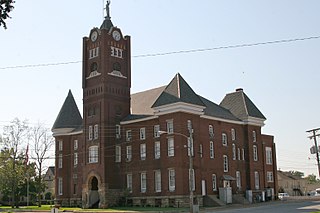
Jackson County is located in the Arkansas Delta in the U.S. state of Arkansas. The county is named for Andrew Jackson, a national hero during the War of 1812. By the county's formation in 1829, Jackson had become the seventh President of the United States. Jackson County is home to seven incorporated towns and four incorporated cities, including Newport, the largest city and county seat. The county is also the site of numerous unincorporated communities and ghost towns. Occupying 633.94 square miles (164,190 ha), Jackson County is the 41st largest county of the 75 in Arkansas. As of the 2010 Census, the county's population is 17,997 people in 7,601 households. Based on population, the county is the 40th-largest county in Arkansas. Although terrain rises in the west, most of Jackson County is within the Arkansas Delta, characterized by largely flat terrain with fertile soils. Historically covered in forest, bayous and swamps, the area was cleared for agriculture by early settlers. It is drained by the White River.

Historic Washington State Park is a 101-acre (41 ha) Arkansas state park in Hemsptead County, Arkansas in the United States. The museum village contains a collection of pioneer artifacts from the town of Washington, Arkansas, which is a former pioneer settlement along the Southwest Trail. Walking interpretive tours are available throughout the 54 buildings. Washington served as a major trading point along the Southwest Trail, evolving into the Hempstead county seat and later the capital of Arkansas from 1863 to 1865 when Little Rock was threatened during the Civil War. The original plat of Washington was added to the National Register of Historic Places in 1972 as the Washington Historic District.

Turkey Creek School is a former school building located along Arkansas Highway 9 in Stone County, Arkansas. It is a single-story wood-frame structure, with a metal gable roof, weatherboard siding, and a stone foundation. The north facade has a symmetrical pair of entrances with simple trim, and the sides have five sash windows. Although it was built in 1925, the school resembles much older rural schoolhouses. It was used as a school until 1949, and now serves as a local community building.

The Woodlawn School Building is a historic former school building near the junction of Bizzell Road and Arkansas Highway 31 in Woodlawn, Lonoke County, Arkansas. It is a single-story wood-frame structure, built with Craftsman styling in 1921. It has a gable-on-hip roof with extended eaves and exposed rafter tails, and large knee brackets supporting the gable ends. The school consolidated three rural school districts.
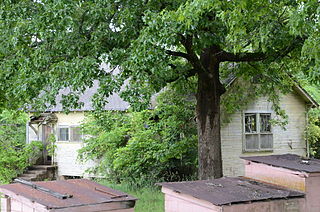
The Cafeteria Building of the Cleveland School is a historic school building in rural Conway County, Arkansas. It is located near the hamlet of Cleveland, on the south side of Center School Road. It is a single-story wood-frame structure, with a gable-on-hip roof, weatherboard siding, and a foundation of stone piers. It has vernacular Craftsman styling, with exposed rafter ends in the eaves, large Craftsman brackets in the gables, and bracketed hoods sheltering the entrances. It was built about 1930, and initially served as a cafeteria for an adjacent elementary school; it was later converted to classroom use.
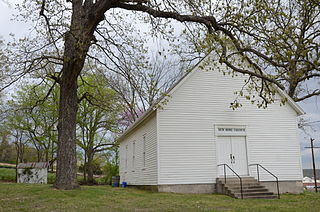
The New Home School and Church is a historic community building on McKisic Creek Road south of Bella Vista, Arkansas. It is a modest single-story wood-frame structure, with a gable roof, which lacks ornamentation. Its main facade has a double-door entrance, and the side facades have three bays of windows. Built c. 1900, it is a well-preserved example of a multifunction vernacular community building, which was used as a school during the week and as a church on Sundays. The school function was discontinued after schools in the area were consolidated.

The Roasting Ear Church and School is a historic multifunction building in rural northwestern Stone County, Arkansas. It is located northeast of Onia, on County Road 48 west of its junction with County Road 86. It is a single-story wood-frame structure, with a front-facing gable roof, weatherboard siding, and stone foundation. The main facade has a pair of symmetrically-placed entrances with transom windows and simple molding, and otherwise lacks adornment. Built c. 1918, it is a well-preserved example of a typical rural Arkansas structure built to house both a church congregation and a local school.
Jackson County School District (JCSD) is a school district in Jackson County, Arkansas, headquartered in Tuckerman. It serves Tuckerman, Campbell Station, Grubbs, Swifton, and a portion of Diaz.
Sneed is a ghost town in Jackson County, Arkansas, United States. It was abandoned in 1929 following an F5 tornado.

The Immanuel High School is a historic school building in rural Arkansas County, Arkansas. It is located at 68 Immanuel Road, about 0.5 miles (0.80 km) east of Arkansas Highway 33, east of Almyra. It is a single-story wood-frame structure in a U shape, covered in siding, with a cross-gable roof. Built c. 1940, it is the only surviving element of the Immanuel Industrial Institute, a larger complex of buildings built to educate the local African-American population. The complex was merged into a regional school district in 1950, and was closed in 1966. It was used for a variety of other private and non-profit educational purposes afterward, but has been vacant since the mid-1990s.

The Poughkeepsie School Building is a historic school building in Poughkeepsie, Arkansas, between Arkansas Highway 58 and Cherry Street. It is a single-story fieldstone building in the shape of an H, with front-gabled wings flanking a central horizontally-ridged section. The school was built in 1929–30, and is a well-preserved representative of a rural Arkansas stone school of the period.

The Eros School Building is a historic school building in the small rural community of Eros, Arkansas, at the junction of Arkansas Highway 125 and Marion County Road 4018. It is a single-story Plain Tradition stone structure, with a Craftsman-style side-gable roof with exposed rafter tails. A gable-topped porch projects from the main (west-facing), supported by slender columns on a concrete base. The porch pediment, like those on the sides, is stuccoed. The school was built in 1935 as part of a Depression-era jobs program.
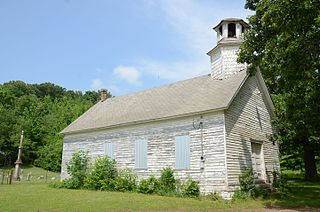
The Shady Grove Delmar Church and School is a historic church and school building in rural Carroll County, Arkansas, US. The building, a single story wood-frame structure with a gable roof, weatherboard siding, and a distinctive hexagonal tower with belfry and cupola. The building was built c. 1880 to provide a space for both religious services and a district school. It is a virtually unaltered example of the type, which was once common in rural Arkansas. The building is located on County Road 933, about 1.4 miles (2.3 km) west of the hamlet of Delmar, on the north side of Osage Creek.

The Mineral Springs Community Building is a historic multiuse civic building on County Road 34 in rural Washington County, Arkansas east of West Fork. It is a modest single-story wood-frame structure, with a gable roof, clapboard siding, and a stone foundation. It was builtin 1915 and enlarged in 1947, giving it its present T shape. The building served the local community as a school, town meeting hall, and church, with the use as a school ending in 1946. The building is a significant example of a surviving one-room schoolhouse in the county.

The Big Four School was a historic school building in rural White County, Arkansas. Located on the west side of County Road 383, it was a vernacular single-story wood-frame structure, whose exterior was finished in novelty siding. The front entrances were sheltered by a single gable-roofed portico supported by columns on piers. The building was constructed in 1915, but was extensively altered in the 1930s with Works Progress Administration funding. The building was rare because of its siding, and because of its association with the WPA. When listed on the National Register of Historic Places in 1992, it was described as abandoned and in deteriorating condition. It has been listed as destroyed in the Arkansas Historic Preservation Program database.
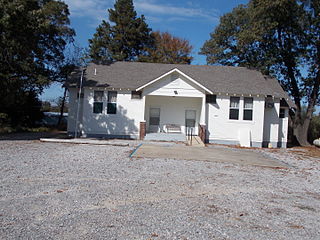
The Thida Grove School is a historic school building in the rural community of Thida in southern Independence County, Arkansas. Located on the north side of County Road 20, it is a single-story vernacular wood-frame structure, with a side gable roof, weatherboard siding, and a concrete foundation. It has a recessed porch with a pair of entrances. The interior has a single large chamber, with tongue-and-groove wainscoting and wide oak flooring. The school was built about 1920 during a boom period in the region.

The Oak Grove School is a historic school building in rural eastern Grant County, Arkansas. It is located on the south side of United States Route 270, about 6 miles (9.7 km) east of Sheridan, and is now home to the Center Grove United Methodist Church. It is a single-story wood-frame structure, with a hip roof and novelty siding. It was built in 1938 with funding from the Works Progress Administration, and originally housed four classrooms. It was used as a school until 1950, and has served as the church since then.

The New Mt. Pisgah School is a historic school building in rural White County, Arkansas. It is located northwest of Searcy, on the north side of Smith Road, east of Mt. Pisgah Road. It is a single story stone structure, with a hip roof pierced by dormers, and long eaves with exposed rafter ends. A segmented arch projects in front of the recessed main entrance. The school, now serving as a private residence, was built in 1938 with funding from the Works Progress Administration, and is one of the county's few surviving examples of a WPA school.

The New Liberty School is a historic school building in rural Logan County, Arkansas. It is located east of New Blaine, on the south side of Arkansas Highway 22 east of the New Liberty Church. It is a single-story masonry structure, built of coursed stone and covered by a metal hip roof. Its front entrance is sheltered by a gabled portico supported by simple square posts set on brick piers. It was built in 1922, and is a well-preserved example of an early 20th-century school, built before Arkansas instituted significant reforms in school building standards.
Swifton School District No. 33 was a school district headquartered in Swifton, Arkansas. It had a single school, the Swifton School.


















